
Albert Joseph Moore (1841-1893) stands as a significant yet sometimes overlooked figure in the rich tapestry of nineteenth-century British art. A key proponent of the Aesthetic Movement, Moore dedicated his career to the pursuit of beauty in its purest form, creating paintings celebrated for their exquisite colour harmonies, refined compositions, and depictions of serene, classically draped female figures. Born into an artistic dynasty and navigating the complex currents of Victorian art, Moore forged a distinctive path, prioritizing visual delight over narrative or moral content, leaving behind a legacy of captivating and decorative works.
An Artistic Heritage: Early Life and Education
Albert Joseph Moore was born in York on September 4, 1841, into a family deeply immersed in the arts. He was the thirteenth son and fourteenth child of William Moore, a respected portrait and landscape painter, and his wife, Sarah Collingham. Growing up surrounded by artistic activity, Albert and several of his siblings, notably the successful marine painter Henry Moore and the artist John Collingham Moore, received their initial artistic guidance from their father. This familial environment undoubtedly nurtured his innate talent from a young age.
His formal education took place at Archbishop Holgate's School and later St Peter's School, both in York. His precocious ability was recognized early; in 1853, at the tender age of twelve, he won a prize from the Department of Arts and Sciences in Kensington. This early success hinted at the promising career that lay ahead. Following his father's death in 1851, the family relocated to London, placing the young Albert closer to the centre of the British art world.
In 1857, Moore enrolled in the Royal Academy Schools, formally beginning his academic training. He became a full student of the Royal Academy in 1862. During these formative years, he absorbed the prevailing artistic trends. Initially, like many young artists of the time, he showed the influence of the critic John Ruskin, whose emphasis on truth to nature and detailed observation was highly pervasive. Moore's early works reflected this, often featuring biblical subjects rendered with meticulous attention to detail, characteristic of the Pre-Raphaelite Brotherhood's influence, though he was never formally a member.
The Turn Towards Classicism and Aestheticism
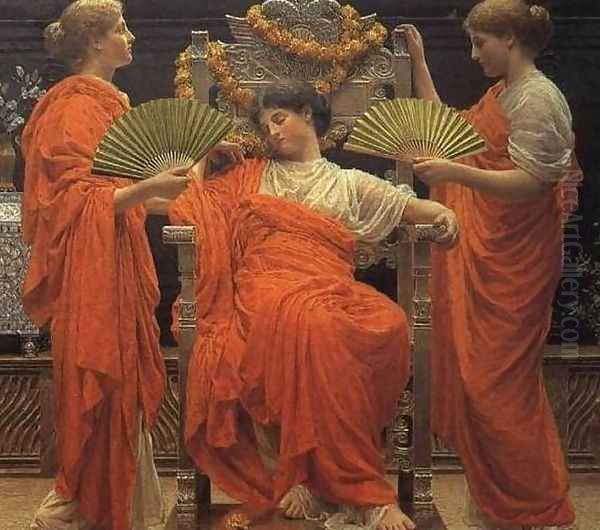
A pivotal shift occurred in Moore's artistic direction around the early 1860s. He began to move away from the Ruskinian emphasis on detailed naturalism and narrative complexity. A trip to Rome in 1862-1863, undertaken with the architect William Eden Nesfield, proved transformative. Exposure to classical sculpture and Renaissance frescoes profoundly impacted his sensibilities. He became increasingly fascinated by the formal qualities of ancient Greek sculpture, particularly the Elgin Marbles housed in the British Museum, studying their drapery, poses, and idealized forms.
This immersion in classical art steered him towards the principles that would define his mature style. He began to prioritize aesthetic harmony, colour arrangement, and decorative pattern above all else. His subjects shifted from biblical or historical narratives to compositions featuring elegant, often languid, female figures in vaguely classical settings. These figures, draped in flowing robes, rarely engage in specific actions or tell a story; instead, they exist primarily as elements within a carefully orchestrated design, embodying grace and beauty for its own sake.
This approach aligned perfectly with the burgeoning Aesthetic Movement, which championed the doctrine of "Art for Art's Sake" (l'art pour l'art). This philosophy held that art should be self-sufficient, judged on its own intrinsic beauty – its form, colour, and composition – rather than its narrative, moral, or social message. Moore became one of the movement's leading exponents in painting.
Style, Subject, and Technique
Albert Moore's mature style is instantly recognizable. His paintings are characterized by a delicate and sophisticated sense of colour harmony. He often employed subtle, closely related tones, creating palettes that are both refined and visually pleasing, sometimes incorporating bolder accents for contrast. His handling of paint was smooth and meticulous, resulting in surfaces that possess a porcelain-like finish.
His primary subject matter consisted almost exclusively of female figures, singly or in groups. These women are typically depicted in relaxed, contemplative poses – sleeping, reading, arranging flowers, or simply existing within beautifully appointed interiors or against decorative backdrops. They are invariably clad in classical-style drapery, which Moore rendered with exceptional skill, capturing the intricate folds and textures of the fabric. While the settings evoke antiquity, they are not archaeologically precise reconstructions but rather idealized, decorative environments designed to enhance the overall aesthetic effect.
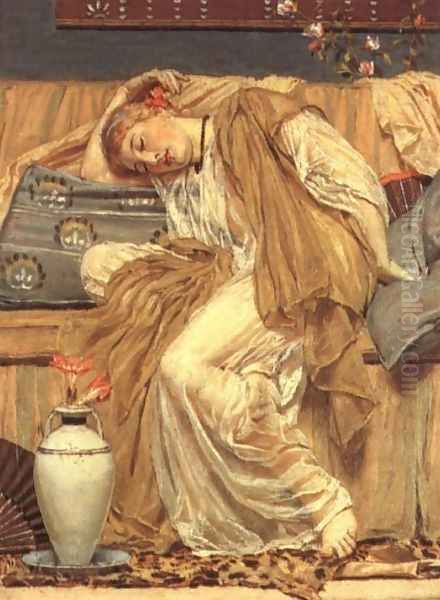
Moore was a master of composition, arranging his figures and decorative elements with a keen sense of balance and rhythm. Symmetry often plays a role, but it is usually nuanced rather than rigid. He frequently incorporated decorative motifs such as flowers, patterned fabrics, tiles, and musical instruments, integrating them seamlessly into the overall design. There is also evidence of influence from Japanese art, particularly in the flattened perspectives, asymmetrical compositions, and decorative patterning seen in some works, a trend shared by contemporaries like James McNeill Whistler.
The mood evoked by Moore's paintings is typically one of serenity, languor, and quiet contemplation. His figures often appear detached, absorbed in their own tranquil world, contributing to the sense that the paintings are primarily visual arrangements rather than dramatic scenes. This intentional lack of narrative or overt emotion was central to his aesthetic philosophy.
Friendships and Artistic Circles
Throughout his career, Moore maintained important relationships with fellow artists who shared similar aesthetic goals. His most significant friendship was with the American expatriate painter James McNeill Whistler. The two met in the mid-1860s and developed a close bond based on mutual admiration and shared artistic principles. Whistler deeply respected Moore's mastery of drawing and decorative design, while Moore was likely influenced by Whistler's innovative approach to colour and composition. They sometimes worked in close proximity and undoubtedly exchanged ideas, both contributing significantly to the development of Aestheticism in Britain.
Moore was also associated with other prominent figures in the Victorian art world. He had connections with leading classical painters like Frederic Leighton, President of the Royal Academy, whose own works often featured idealized figures and classical themes, albeit usually with more narrative content than Moore's. He also moved in circles that included artists influenced by Pre-Raphaelitism who later embraced Aesthetic ideals, such as Edward Burne-Jones and Simeon Solomon. Interactions with figures like William Blake Richmond also formed part of his professional landscape.
Despite these connections, Moore maintained a degree of independence. His outspoken nature and unwavering commitment to his artistic principles sometimes put him at odds with the establishment. He frequently exhibited at the Royal Academy but was never elected a member or associate, possibly due to his perceived radicalism or his criticism of the institution's more conservative elements. This independent streak contributed to his reputation as a somewhat isolated figure, dedicated wholly to his unique artistic vision.
Representative Works: A Symphony of Form and Colour
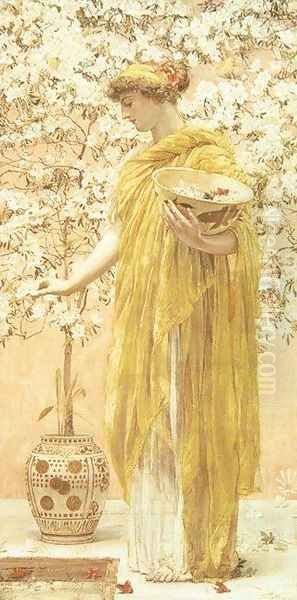
Moore's oeuvre includes numerous paintings that exemplify his distinctive style. Among his most celebrated works is Midsummer (1887, Russell-Cotes Art Gallery & Museum, Bournemouth). This large canvas depicts three women seated on an ornate, orange-draped throne-like structure against a dark background. The central figure is awake, while the flanking figures appear drowsy or asleep. The painting is a masterful study in colour harmony, dominated by shades of orange, yellow, and gold, and showcases Moore's skill in rendering complex drapery and serene expressions.
A Sleeping Girl (c. 1868-1870, Minneapolis Institute of Art) is another quintessential Moore subject, presenting a single figure lost in slumber, her form elegantly arranged and her drapery meticulously rendered. It highlights his ability to capture grace in repose.
Quartette: A Painter's Tribute to the Art of Music (1868) is notable for depicting four male figures in classical attire playing modern musical instruments. While still focused on aesthetic arrangement, it deviates slightly from his usual female subjects and explicitly links the harmony of music with the harmony of visual art.
Violets (1868) shows a standing female figure holding a tray of flowers. It is admired for its delicate colour scheme and the subtle integration of potentially Eastern-inspired decorative elements alongside the classical drapery, showcasing his ability to blend influences into a harmonious whole.
Azaleas (1867-1868) features a woman standing before a backdrop of vibrant azalea blossoms, contemplating a sprig she holds. The work contrasts the delicate figure with the rich texture and colour of the flowers, demonstrating his sensitivity to natural forms within his decorative schemes.
Earlier works like The Sacrifice of Isaac (1865) and The Shunamite relating the Glories of King Solomon to her Maidens (1866) represent his transition phase, still engaging with biblical subjects but already showing a greater emphasis on decorative composition and idealized figures compared to strict narrative realism.
His last major work, The Loves of the Winds and the Seasons (completed 1893), depicts allegorical figures in a dynamic, flowing composition. Finished just days before his death, it serves as a testament to his enduring dedication to his art, even in failing health. It encapsulates his lifelong pursuit of rhythmic design and harmonious form.
Other notable works include Beads (c. 1875), Shells (1874), Dreamers (1882), and paintings simply titled with colours or decorative elements like Silver (1886) or Topaz (c. 1879), further emphasizing his focus on the purely visual aspects of his art.
Decorative Arts and Design
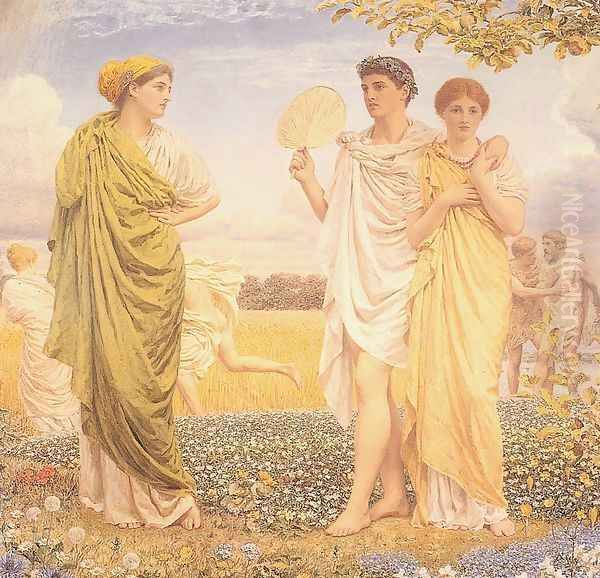
Consistent with the principles of the Aesthetic Movement, which sought to integrate art into everyday life, Moore also engaged in decorative design work. He created designs for various media, including ceramic tiles, wallpaper, and stained glass. This aspect of his career underscored his commitment to decorative harmony and pattern, extending his artistic vision beyond the confines of the easel painting. His designs often featured motifs similar to those found in his paintings – stylized flowers, classical figures, and intricate patterns – demonstrating a unified aesthetic across different forms of expression. This involvement connected him to the broader design reform movements of the era, alongside figures like William Morris, though Moore's focus remained primarily on painting.
Later Life, Personality, and Critical Reception
In his later years, Albert Moore lived a relatively reclusive life in his London studio. Anecdotes suggest he shared his home primarily with his pets – reportedly a number of cats and a dog. Despite suffering from a painful and ultimately incurable illness (likely cancer) towards the end of his life, he remained remarkably dedicated to his work. He continued painting with unwavering focus, completing his final canvas, The Loves of the Winds and the Seasons, just ten days before his death.
Moore passed away in Westminster, London, on September 25, 1893, at the age of 52. He was buried in Highgate Cemetery, a resting place for many notable Victorian figures. A memorial exhibition of his work was held the following year, with showings in Birmingham and Manchester, acknowledging his contribution to British art.
During his lifetime, Moore's work garnered a dedicated following among collectors and fellow artists who appreciated his unique aesthetic, including Whistler and Algernon Charles Swinburne. However, his art also faced criticism. Some found his relentless focus on beauty and lack of narrative or moral content to be superficial or lacking in substance compared to the more didactic or historically focused works of contemporaries like Leighton or Lawrence Alma-Tadema. His independent stance and perceived detachment from conventional academic standards likely contributed to his exclusion from Royal Academy honours. Yet, his paintings were consistently exhibited and often admired for their technical brilliance and decorative appeal.
Market Presence and Enduring Legacy
Today, Albert Joseph Moore is recognized as a leading figure of the British Aesthetic Movement and a master of decorative painting. His works are held in major public collections worldwide, including the Tate Britain (London), the Victoria and Albert Museum (London), the Manchester Art Gallery, the Walker Art Gallery (Liverpool), the Ashmolean Museum (Oxford), the Minneapolis Institute of Art, and the Russell-Cotes Art Gallery & Museum.
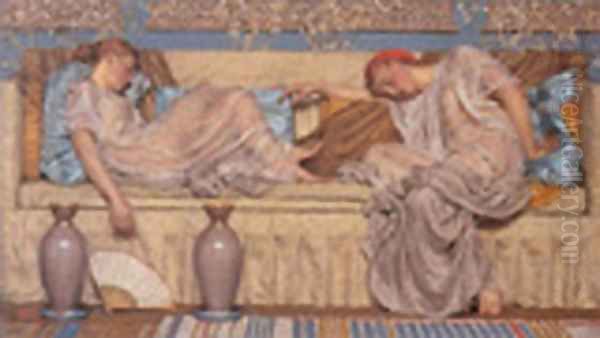
In the art market, Moore's paintings are relatively rare. Due to his meticulous technique and relatively modest output compared to some contemporaries, major works appear infrequently at auction. When they do, they often command significant prices, reflecting their scarcity and desirability among collectors of Victorian art. For instance, his painting Topaz was estimated to sell for between £600,000 and £900,000 at a Sotheby's auction in 2024, indicating the high value placed on his prime works. The limited availability – with perhaps only a handful of comparable pieces appearing on the market over decades – further enhances their status.
Moore's legacy lies in his unwavering dedication to the principle of "Art for Art's Sake." He successfully carved out a unique niche, creating a body of work focused purely on visual harmony, colour, and form. His paintings, with their serene figures, exquisite drapery, and sophisticated colour palettes, offer a distinct vision of beauty that stands apart from the narrative and moralizing tendencies prevalent in much Victorian art. He demonstrated that painting could aspire to the condition of music, evoking feeling and pleasure through abstract qualities rather than storytelling. In doing so, Albert Joseph Moore left an indelible mark on the course of British art, influencing subsequent generations of artists interested in decorative composition and the intrinsic power of aesthetic beauty.